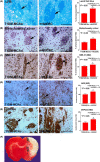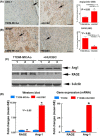HUCBCs increase angiopoietin 1 and induce neurorestorative effects after stroke in T1DM rats
- PMID: 25042092
- PMCID: PMC4180763
- DOI: 10.1111/cns.12307
HUCBCs increase angiopoietin 1 and induce neurorestorative effects after stroke in T1DM rats
Abstract
Background and purpose: We investigated the neurorestorative effects and underlying mechanisms of stroke treatment with human umbilical cord blood cells (HUCBCs) in Type one diabetes mellitus (T1DM) rats.
Methods: Type one diabetes mellitus rats were subjected to middle cerebral artery occlusion (MCAo) and 24 h later were treated with: (1) phosphate-buffered-saline; (2) HUCBCs. Brain endothelial cells (MBECs) were cultured and capillary tube formation was measured.
Results: Human umbilical cord blood cells treatment significantly improved functional outcome and promoted white matter (WM) remodeling, as identified by Bielschowsky silver, Luxol fast blue and SMI-31 expression, increased oligodendrocyte progenitor cell and oligodendrocyte density after stroke in T1DM rats. HUCBC also promoted vascular remodeling, evident from enhanced vascular and arterial density and increased artery diameter, and decreased blood-brain barrier leakage. HUCBC treatment also increased Angiopoietin-1 and decreased receptor for advanced glycation end-products (RAGE) expression compared to T1DM-MCAo control. In vitro analysis of MBECs demonstrated that Ang1 inversely regulated RAGE expression. HUCBC and Ang1 significantly increased capillary tube formation and decreased inflammatory factor expression, while anti-Ang1 attenuated HUCBC-induced tube formation and antiinflammatory effects.
Conclusion: Human umbilical cord blood cells is an effective neurorestorative therapy in T1DM-MCAo rats and the enhanced vascular and WM remodeling and associated functional recovery after stroke may be attributed to increasing Angiopoietin-1 and decreasing RAGE.
Keywords: HUCBC; Neurorestorative therapy; Stroke; T1DM; Vascular remodeling; White matter remodeling.
© 2014 John Wiley & Sons Ltd.
Conflict of interest statement
JC is a consultant to Saneron CCEL Therapeutics, Inc. In addition, CDS & NKN are inventor on cord blood patents/applications. CDS is Sr. VP of R&D, and NKN is President & COO at Saneron CCEL Therapeutics, Inc.
Figures






References
-
- Idris I, Thomson GA, Sharma JC. Diabetes mellitus and stroke. Int J Clin Pract 2006;60:48–56. - PubMed
-
- Yong M, Kaste M. Dynamic of hyperglycemia as a predictor of stroke outcome in the ECASS‐II trial. Stroke 2008;39:2749–2755. - PubMed
-
- Capes SE, Hunt D, Malmberg K, Pathak P, Gerstein HC. Stress hyperglycemia and prognosis of stroke in nondiabetic and diabetic patients: A systematic overview. Stroke 2001;32:2426–2432. - PubMed
Publication types
MeSH terms
Substances
Grants and funding
LinkOut - more resources
Full Text Sources
Other Literature Sources
Medical
Miscellaneous

